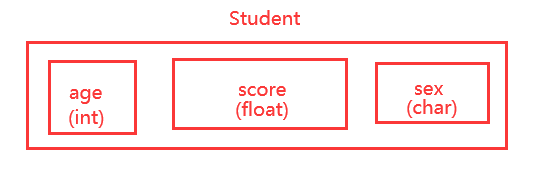结构体
1、为什么需要结构体
为了表示一些复杂的事物,而普通的基本类型无法满足实际要求。什么叫结构体
把一些基本类型数据组合在一起形成的一个新的数据类型,这个叫做结构体(复合数据类型)。
列如:
c
#include <stdio.h>
struct Student//结构体,定义了一个Student的数据类型。由int,float,char类型组成
{
int age;
float score;
char sex;
};//逗号不能省
int main (void)
{
struct Student st = {15, 66.6, 'F'};//给Student类型命名。
return 0;
}
2、如何定义结构体
第一种方式:如上面的例子
第二种方式:
c
#include <stdio.h>
struct Student
{
int age;
float score;
char sex;
}st;//直接在这里定义数据类型的名字
int main (void)
{
struct Student st = {15, 66.6, 'F'};
return 0;
}推荐使用第一种方式。
3、怎么使用结构体变量
3.1、赋值和初始化
赋值:
第一种:struct Student st = {15, 66.6, 'F'};
第二种:struct Student st;
st.age = 15;
st.score = 66.6;
st.sex = 'F';3.2、结构体变量的输出
第一种:
printf("%d,%f,%c\n",st.age,st.score,st.sex);第二种:
struct Student* pst = &st;
printf("%d,%f,%c",pst->age,pst->score,pst->sex);定义一个指针变量pst,用来存放Student数据类型的地址。
pst->age等价于(*pst).age ,也等价于st.age(pst所指向的那个结构体变量中的age这个成员)
代码
c
/*通过函数对结构体变量的输入和输出*/
#include <stdio.h>
#include <string.h>//strcpy使用的声明
void StudentInput(struct Student* pstu);
void StudentOutput(struct Student st);
struct Student
{
int age;
float score;
char name[100];
};
int main (void)
{
struct Student st;
StudentInput(&st);
StudentOutput(st);
return 0;
}
void StudentInput(struct Student* pstu)
{
(*pstu).age = 16;
pstu->score = 66.4f;
strcpy(pstu->name,"李四");
}
void StudentOutput(struct Student st)
{
printf("%d,%f,%s\n",st.age,st.score,st.name);
}ok,学到这里,我们对C语言也算有了基本的了解。其中还有很多的小细节还需要不断的学习进行丰富